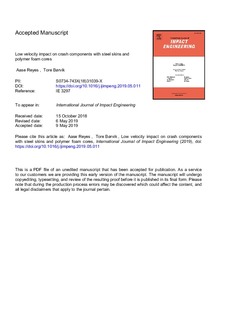| dc.contributor.author | Reyes, Aase | |
| dc.contributor.author | Børvik, Tore | |
| dc.date.accessioned | 2019-09-19T12:39:21Z | |
| dc.date.available | 2019-09-19T12:39:21Z | |
| dc.date.created | 2019-09-02T20:31:04Z | |
| dc.date.issued | 2019 | |
| dc.identifier.citation | International Journal of Impact Engineering. 2019, 132 . | nb_NO |
| dc.identifier.issn | 0734-743X | |
| dc.identifier.uri | http://hdl.handle.net/11250/2617691 | |
| dc.description.abstract | Energy absorbing systems are extensively used in the automotive industry to ensure crashworthiness. Such crash components could typically consist of a sandwich structure with thin ductile plates as skins and a cellular foam as core to dissipate the kinetic energy. In a previous study, the quasi-static behaviour of two polymeric foam types with different densities, namely extruded polystyrene (XPS) and expanded polypropylene (EPP), used as core material in typical crash components was examined. The investigation involved a large number of compression tests of the core materials loaded in different material directions and indentation tests on sandwich structures in different configurations. In the present study, low-velocity impact tests are conducted in a drop tower on the same target configurations consisting of 0.8 mm thick skins of Docol 600DL steel and the various foams as core. During testing, the dropped mass was kept constant at approximately 15 kg, while the impact velocity varied between 5 and 10 m/s. The impact force was registered by the instrumented striker of the drop tower, and these measurements were used to obtain the displacement of the striker and the energy absorption of the different crash components. In addition, high-speed cameras and 3D-DIC were used to measure the out-of-plane displacement of the back skin. The presented results indicate that to minimise the weight and at the same time maximize the energy absorption of the crash component, a low density foam should be used as core material. It is also shown that by proper design, it is possible to optimize the protection level of such components, at least within a given velocity range. | nb_NO |
| dc.language.iso | eng | nb_NO |
| dc.publisher | Elsevier | nb_NO |
| dc.rights | Attribution-NonCommercial-NoDerivatives 4.0 Internasjonal | * |
| dc.rights.uri | http://creativecommons.org/licenses/by-nc-nd/4.0/deed.no | * |
| dc.title | Low velocity impact on crash components with steel skins and polymer foam cores | nb_NO |
| dc.type | Journal article | nb_NO |
| dc.type | Peer reviewed | nb_NO |
| dc.description.version | acceptedVersion | nb_NO |
| dc.source.pagenumber | 15 | nb_NO |
| dc.source.volume | 132 | nb_NO |
| dc.source.journal | International Journal of Impact Engineering | nb_NO |
| dc.identifier.doi | 10.1016/j.ijimpeng.2019.05.011 | |
| dc.identifier.cristin | 1720767 | |
| dc.description.localcode | © 2019. This is the authors’ accepted and refereed manuscript to the article. Locked until 10.5.2021 due to copyright restrictions. This manuscript version is made available under the CC-BY-NC-ND 4.0 license http://creativecommons.org/licenses/by-nc-nd/4.0/ | nb_NO |
| cristin.unitcode | 194,64,45,0 | |
| cristin.unitname | Institutt for konstruksjonsteknikk | |
| cristin.ispublished | true | |
| cristin.fulltext | postprint | |
| cristin.qualitycode | 2 | |

